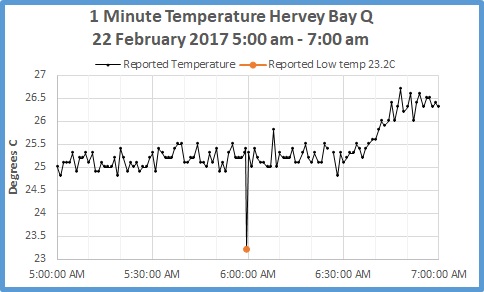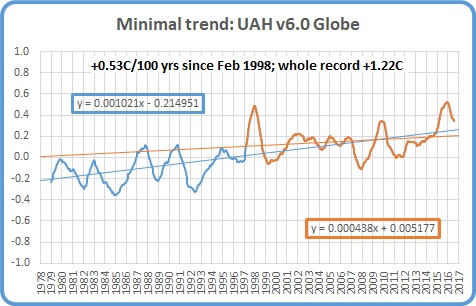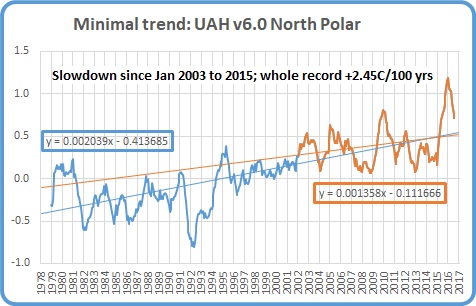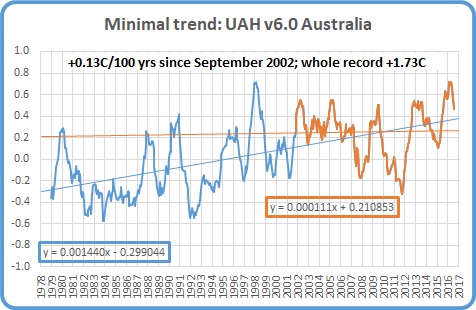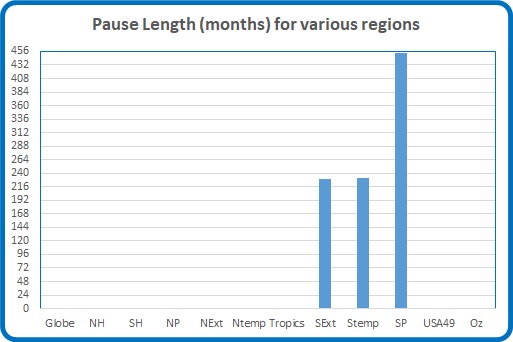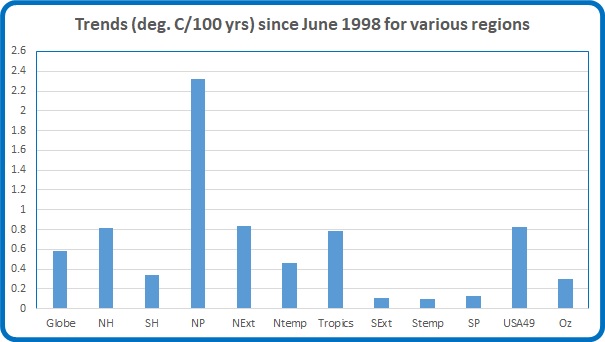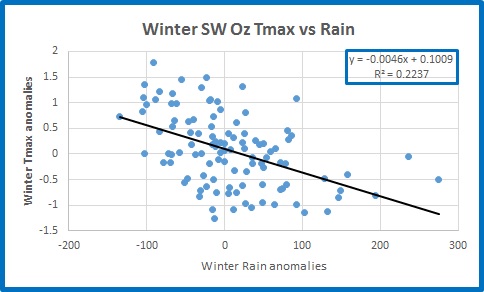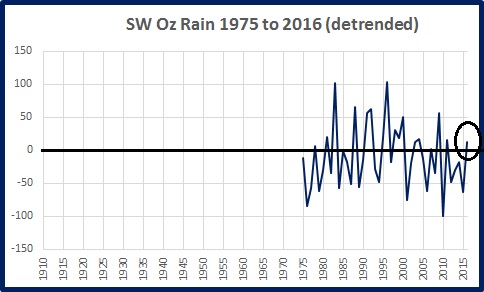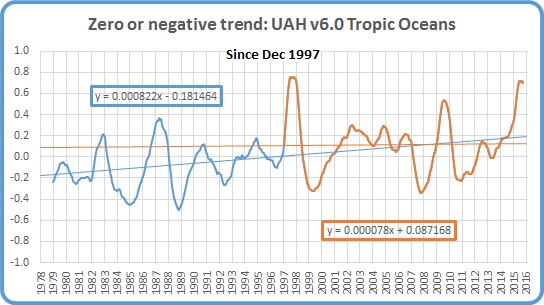The current drought conditions in New South Wales and large parts of Queensland are getting a lot of media attention, and of course the usual suspects are linking it to climate change and our apparently “unambitious” emissions targets in the NEG. But are droughts really becoming “the new normal”, and are they becoming more frequent, more intense, and more widespread with global warming?
There are two aspects to consider: long term rainfall trends in various regions, and periods of rainfall deficiency. In this post I will look at long term rainfall, and Part 2 will look at rainfall deficiency i.e. drought incidence.
Long term rainfall trends
Everyone “knows” southern Australia is getting drier. Paul West in Feeding Australia Pt 2 on the ABC says there has been a 28% decrease in rainfall over the past 30 years. The Climate Council says “Over the past 30 years, there has been a discernible decrease in rainfall across southern Australia.” That’s their headline; in the details the Climate Council’s June 2018 Fact Sheet says:
“Climate change has contributed to a southward shift in weather systems that typically bring cool season rainfall to southern Australia. Since the 1970s late autumn and early winter rainfall has decreased by 15 percent in southeast Australia, and Western Australia’s southwest region has experienced a 15 percent decline in cool season rainfall.”
Both are true, but both are only half true, and in fact the ABC and the Climate Council as usual lie by omission.
The whole story is more complex but shows a completely different, and much less dramatic picture. Using data for cool season (April- September) rainfall from the Bureau of Meteorology we can check on different time periods.
Fig. 1: Cool season rainfall, Southern Australia, 1988-2017

Yes, if this is what Paul West based his statement on, 2017 had about 28% less rain than in 1988. I hope he didn’t- comparing single years would be pretty bad science. However there has been a marked decrease in cool season rainfall over this period, so the Climate Council is quite correct.
However, Figure 2 shows the big picture- since 1900.
Fig. 2: Cool season rainfall, Southern Australia, 1900-2017

Oops! Rainfall has in fact increased over southern Australia.
The reason for the current gnashing of teeth is that “living memory” only goes back about 70 years, and we are comparing current conditions with those of a few decades ago. Figure 3 shows the average rainfall for the 10 year periods up to 2017.
Fig. 3: 10 year average Cool season rainfall, Southern Australia, 1900-2017

As you can see, the average rainfall of the 10 years 2008 to 2017 was about 7% less than in the 1950s, 1970s, 1980s, and 1990s, but more than the 1920s and 1930s, and nearly 10% more than the 10 years to 1947. Of the 10 decades before this one, five had less rain and five had more. Southern Australian cool season rainfall is not “the new normal”, it is in fact “the old normal”.
Let’s now look at South-East Australia, below 33 degrees South and east of 135 degrees East.
Fig. 4: Cool season rainfall, South-Eastern Australia, 1988-2017

Again there is an obvious decrease in rain over the last 30 years.
Fig. 5: Cool season rainfall, South-Eastern Australia, 1900-2017

There has been a small decrease in cool season rainfall over the whole 118 years. Again there was a marked step up in rainfall from the mid-1940s. The plot of 10 year averages shows this more clearly:
Fig. 6: 10 year average cool season rainfall, South-Eastern Australia, 1900-2017

There was a decreasing trend up to the 1940s, and a decreasing trend from the 1950s to now. The current 30 to 40 year decrease is nothing new.
However, rainfall records for individual sites go back much longer. What do these show? Here is a plot of monthly rainfall for all months at Penola, in South Australia, starting in 1863:
Fig. 7: Monthly rainfall (all months January 1863 – December 2017) at Penola, S.A.

A very long term decreasing trend. Running 12 month totals show wetter and drier periods:
Fig. 8: 12 month running total rainfall (all months January 1863 – December 2017) at Penola, S.A.

There were very severe droughts around World War 1 and the late 1960s, but a big step up in the 1950s. This is more obvious in a plot of 10 year totals:
Fig. 8: 120 month running total rainfall (all months January 1863 – December 2017) at Penola, S.A.

This site shows a very long term rainfall decrease, complicated by droughts and strings of wetter years, and a huge step up in the middle of last century. This site is one of many of varying lengths in the High Quality Rainfall dataset. Nearly all show the mid-century step up, some show a small long term increase, some show a small long term decrease.
I amalgamated all 84 stations, and here are the plots for all months. Firstly, the number of stations reporting:
Fig. 9: Count of all stations in S.E. Australia reporting, all months

There are a number of long term sites. There were 50 sites in 1898, as in 2017 (several had not yet reported January 2018).
Note: the following plots are of naïve means: there is no area averaging.
Fig. 10: S.E. Australia monthly rainfall (all months)

Note a small increase. Now 12 month running totals of these means:
Fig. 11: S.E. Australia 12 month rainfall (all months)

Now the 10 year running total of monthly means, but since 1898 when the number of stations was the same as now:
Fig. 12: S.E. Australia 120 month rainfall (all months)

The mid-century step up is obvious, with a decline since then. The 10 year rainfall to December 2017 is about what it was a century ago.
I now turn to South West Australia.
Fig. 13: Cool season rainfall, South-Western Australia, 1988-2017

A very serious decline since 1988.
Fig. 14: Cool season rainfall, South-Western Australia, 1900-2017

As you can see, the decline has been around since 1900, but with a marked step down starting in 1968, with a steep but uneven decline since then. 10 year averages show this clearly.
Fig. 14: 10 year average cool season rainfall, South-Western Australia, 1900-2017

Conclusion:
The long term data show a complex picture of long term cool season rainfall decline in south-west and some parts of south-east Australia, while southern Australia as a whole shows a very small increase. It is true that rainfall has declined, as the Climate Council and ABC claim, over the past 30 and 40 years in many parts, but that is only half the story. The whole story is much less dramatic. Rainfall has been declining for a long time in WA, and in south-east Australia has been declining in two stages, separated by a large step up in rainfall in the middle of last century.
The current low rainfall is not “the new normal” but entirely consistent with “the old normal” and should be seen as just plain “normal”. This is Australia. Get used to it.




















